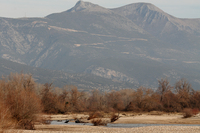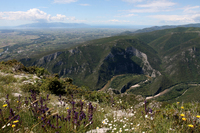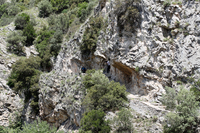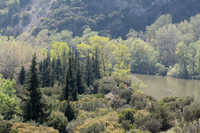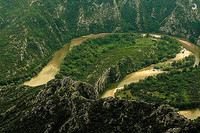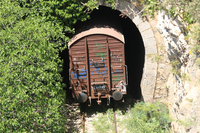Nestos

The entrance of Stena Nestos after a course of 243 kilometers from Rila Mountains in Southern Bulgaria and then through Rodopi ,covering 130 kilometers of the Greek territory , arrives near the end of his route , which is the point slightly before reaching the Aegean sea , in the river Delta opposite the island of Thassos. From this point on and for 20 kilometers to the north, the unique snakelike shape of the river is created, which has been shaped by the constant motion of the water for thousands of years. The continuous flow of the water eroded the limestone rocks on the shore and formed the steep, overgrown, riparian, vertical sides and the extensive sandy beaches, where the natural flow of the river permits. Since 1877, the surrounding area of the Straits, is characterized as “Aesthetic Forest” and is protected by the Greek legislation. The main mountain massif, around the Straits of Nestos, that is the Lekani Mountains and the mount of Achladovouno (Chal), create a closed valley, which consists almost exclusively of marble rocks which are characterized by high permeability. Consequently, substantial amounts of water are trapped inside the rock mass of the mountain. Gradually, due to these waters, many sources of water are created at the lowest parts of the mountain. This happens due to the erosion of limestone rocks and thus, large cavities are formed, which often communicate with each other. This geological phenomenon results in water springing at various points of the rock mass and the river banks. Sufficient quantities of this water accumulated from the fog, the rain and the snow is trapped inside the adjacent mountains which are crossed by the river. Thus the river, in turn, provides the region all year round with clear fresh water. From this point, starts the old stone path, which is often carved into the rock of the mountain. For many years, this path used to link with the valley and by extension with the wider economic life of the place, the old settlements Livera and Kromniko. The whole area of the Straits of Nestos is known at a European level, for the variety of wild flowers and other important species of flora and fauna, which are observed all year round. In the riparian vegetation, from the beginning of the route, among the dense greenery in various positions, bloom from the early spring beautiful wild flowers, such as various types of Orchid. Impressive is the presence of Mediterranean plant species of the orchid Orchis italica, which grows among rocks and bushes at the beginning of the trail. We often see this Orchid in groups, in well-sheltered, shady places. The blossoms of the Orchid appear in April in a dense, pyramidal inflorescence and range from dark to light pink, with bright purple spots and stripes. Morphologically, it reminds the anthropomorphic orchids, which we also encounter in other orchid species in the region. The Haberlea rhodopensis, is a rare plant for our country and endemic of the Rhodope Mountains. It belongs to the family of Gesneriads, which consists mainly of tropic plants. So the Haberlea of Rhodope grows in shady limestone areas and in dense parts between the cracks of rocks and where it is possible for the steep rocks to hold little soil and moisture. Here, the Straits of the river, and the cracks of the rocks, consist one of the few areas where this species flourishes in Greece. In Greece, we also find it in the mountains of Menikio, Falakro and Pageo of Macedonia, whereas in Thrace we find it in the Rhodope Mountains and Mount Papikio. The leaves of this plant are serrated and green on top and are covered by lint, while underneath they are brown colored. It is a perennial plant and a protected species from the Greek and European legislation. Among vertical cliffs and at usually steep, sunny places grow the durable Red Tulips (Tulipa Hageri) in small groups. This plant is an endemic species of South Eastern Europe, which can be found in Greece, Bulgaria and Turkey. The plant does not exceed a height of 15 cm. Today, it is a quite rare species in the Greek nature, although it has a wide geographical distribution, from southern Greece to Thracian region. In the area we find them, even at an altitude of more than 1,000 meters. Colorful Irises are found in similar surroundings where tulips are found; in scattered, rocky, always sunny, but more accessible places. Their name comes from Antiquity and means colorful rainbow. They are perennial bulbous plants. In this area we could find a specific species of Iris called Iris reichenbachii. This type of Iris is endemic in South East Europe. In Greece it is observed only at the north part of the country. This Iris’s colours vary, ranging from white, yellow, up to deep violet. These species are spread from the troughs all the way up to the peaks of the mountains and they could even be seen on altitudes greater than 1000 meters. The Blue Rock Thrush The Blue Rock Thrush is a bird which we cannot find in general in these lands. However, at steep rocks and often in low altitude and close to the trail, we can find the Blue Rock Thrush (Monticola solitarius longirostris). The bird takes its name from the colour of the male bird while the female looks more like the female Common Blackbird, ie brown. The bird is a summer visitor and very alerted when there is human presence. Therefore, when the bird feels there are people close by, it moves quickly to “safer” places on steep sites with good coverage. The bird feeds on various seeds, nuts, invertebrates, insects, and even small reptiles which searches at the wider area. The nest of the Blue Rock Thrush is well hidden in bushes, rocks or cracks and hardly could it be marked. Lastly the bird’s singing is very melodic.

